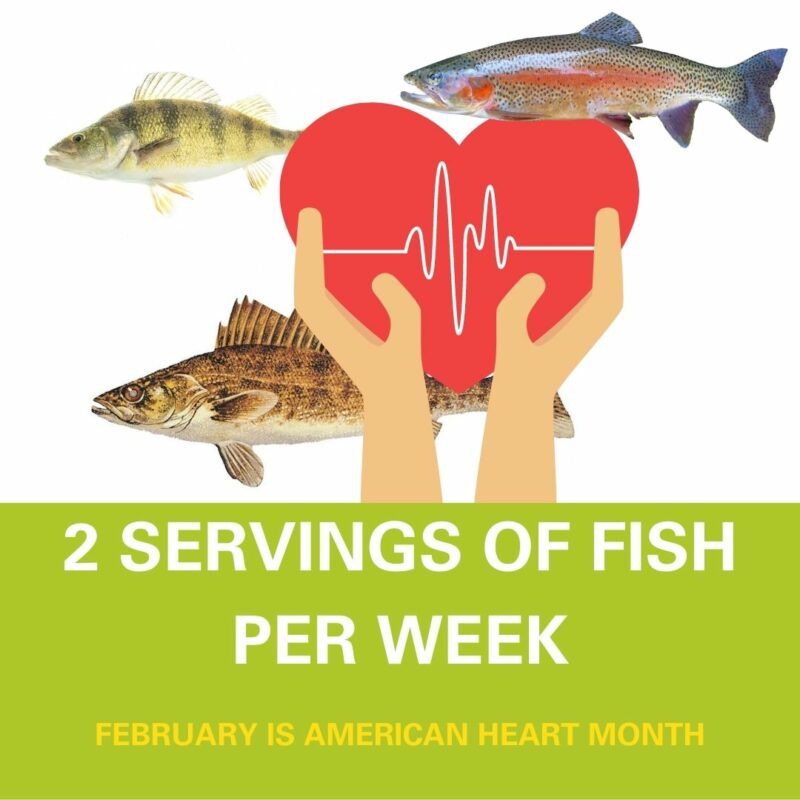
Fish and the Human Heart
“Eat at least two servings of fish each week.”*
(American Heart Association[1] and the U.S. Food and Drug Administration[2])
With respect to matters of the heart, the American Heart Association and the U.S. Food and Drug Administration (FDA) tend to put fish on a pedestal. They do this because fish is a wonderful source of protein that can be rich with omega-3 fatty acids and other nutrients shown to support heart health. Omega-3 fatty acids can:
- Decrease triglycerides
- Lower blood pressure slightly
- Reduce blood clotting
- Decrease the risk of strokes and heart failure
- Reduce irregular heartbeats
- Reduce inflammation throughout the body. (Inflammation can damage blood vessels and lead to heart disease and strokes.)
Fish from colder climates, like Wisconsin, top the charts when it comes to omega-3 fatty acids. Omega-3-rich fish options produced in Wisconsin waters include:
- Lake trout (wild-caught Great Lakes)
- Lake whitefish (wild-caught Great Lakes)
- Lake herring (wild-caught Great Lakes)
- Chubs (wild-caught Great Lakes)
- Rainbow smelt (wild-caught Great Lakes)
- Atlantic salmon (farm-raised in Wisconsin)
- Rainbow trout (farm-raised in Wisconsin)
To tend to matters of the heart, it’s best to keep fish fries to a minimum. Your taste buds might say, “YES!” to fried foods but your heart (and waistline) will likely be yelling, “No!” Techniques like sautéing, broiling, baking, grilling or microwaving are perfect for cooking all kinds of fish. Find sumptuous recipes HERE.
A word about mercury and other contaminants
For most adults, the health benefits of eating fish outweigh the risk of ingesting threatening levels of mercury, dioxins, polychlorinated biphenyls (PCBs) and per- and polyfluoroalkyl substances (PFAS). The amount of toxins a fish carries depends on species, age and where it’s caught. For example, a big old mackerel that swims in the ocean eating smaller fish for a living can contain high levels of mercury (average 1.4 ppm).[3] On the other hand, lake whitefish and lake trout harvested from Lake Superior carry much lower mercury loads at about 0.06 ppm and 0.12 ppm, respectively.[4]
Mercury can cause problems for unborn and young children, affecting the development of the brain and nervous system. Because of this, the FDA and the Environmental Protection Agency recommend:[5]
- Women — pregnant, plan to become pregnant or breast-feeding — eat up to 12 ounces of seafood per week from a variety of choices that are lower in mercury contamination.
- Children — eat fish from choices lower in mercury once or twice a week. Serving size for children younger than age 2 is 1 ounce.
Further, they recommend that these groups of people eat no more than 4 ounces of Albacore tuna a week and no fish that’s typically high in mercury, such as shark, swordfish, king mackerel and tilefish.
*A serving size is 4 ounces before cooking, about the size of a deck of cards or the palm of an adult hand.
[1] www.heart.org/en/news/2020/09/14/when-it-comes-to-healthy-protein-fish-is-the-dish
[2] www.fda.gov/food/consumers/advice-about-eating-fish
[3] https://meridian.allenpress.com/jfp/article/77/8/1361/174257/Mercury-Content-in-Commercially-Available-Finfish
[4] https://www.ncbi.nlm.nih.gov/pmc/articles/PMC6173632/#:~:text=In%20our%20most%20recent%20assessment,0.122ppm%20for%20lake%20trout.
[5] https://bit.ly/2OQwj7L (EPA link)


